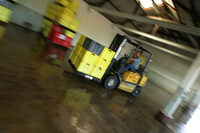 Just about any manufacturing business, and many other types of company, will require warehousing or other storage space of one sort or another. Large or small, managing that space comes with risks – and they may not be in places you’ve anticipated. As a business owner, you have a legal duty to protect your employees and the public from harm, to the extent that this is possible. Key to keeping safe is good risk assessment, which will identify:
Just about any manufacturing business, and many other types of company, will require warehousing or other storage space of one sort or another. Large or small, managing that space comes with risks – and they may not be in places you’ve anticipated. As a business owner, you have a legal duty to protect your employees and the public from harm, to the extent that this is possible. Key to keeping safe is good risk assessment, which will identify:
- Where the potential dangers lie
- Who is at risk, and
- What you might do to mitigate the problem.
Warehouse safety
All things being equal, comparatively few accidents happen in warehouses. Far more problems occur in manufacturing and transporting goods than in their storage – perhaps because the purpose of storage is simply to keep things in one place until they are needed. Nevertheless, every year thousands of warehouse accidents are recorded, ranging from relatively minor through to serious injury.
Where there are risks there are legislation and guidelines, and the Health and Safety Executive (HSE) has published a booklet laying out the major areas to watch. Some of these are technical, and to do with the physical properties and limitations of your warehouse space. There are the checks you might expect: that floors are level and robust, that there is adequate ventilation, heat and fire safety is observed, loading tolerances for shelving are met, and so on.
More broadly, there is attention to specific detail around handling – whether manually or mechanically – and best practice when working at height. However, the bulk of the booklet consists of general material around responsible practice and the prevention of avoidable accidents. You can find full guidelines from the Health and Safety Executive here.
The Management of Health and Safety at Work Regulations (1999) require that employers instigate appropriate health and safety arrangements. These do not require that you eliminate all risk – only that you should make every effort to protect your employees, as far as can reasonably be expected.
Common problems
The most common warehouse safety incidents fall into three categories:
1) Slips, trips and falls
2) Musculo-skeletal problems related to lifting, pulling, reaching and so on
3) Handling accidents like falling containers and forklift incidents.
Roughly a quarter of serious injuries – including broken bones and other accidents involving overnight hospitalisation – are caused by trips or falls. Falls from a height account for around one in seven major injuries, as does being hit by falling objects. Forklift accidents account for one in ten injuries.
Avoiding injury
The nature of serious incidents means that there are two things that warehouse managers must do:
- Conduct a risk assessment
- Carry out training, where required
A large proportion of injuries are completely avoidable and many of the insights you will gain are just common sense – storing heavier containers at lower levels, for example, and ensuring that pallets are stacked appropriately.
What you may not have appreciated is that the worst accidents tend not to involve such obvious examples as trips, falling containers or collisions. For worse injuries (leading to seven-day or more absences from work), the most common cause is problems deriving from manual handling practices. Almost half of longer absences are caused by these issues. Injuries of the upper body (back, neck, shoulders and arms) are often caused by overexertion, poor posture and lifting technique. Other injuries to the feet, knees and ankles are caused by squatting and kneeling awkwardly. These comprise a significant proportion of the incidents that require time off work and compensation – demonstrating the need for, and value of, proper training.
This post was brought to you by the warehouse design, supply and install specialists – ESE Projects.